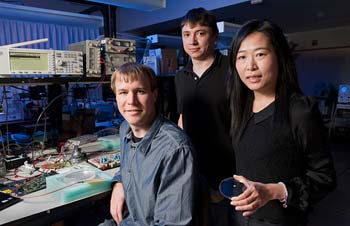For 50 years, scientists searched for the secret to making tiny implantable devices that could travel through the bloodstream. Engineers at Stanford University have demonstrated just such a device. Powered without wires or batteries, it can propel itself though the bloodstream and is small enough to fit through blood vessels.
|
ADVERTISEMENT |
At the International Solid-State Circuits Conference in February 2012, Stanford University electrical engineer Ada Poon demonstrated a tiny, wirelessly powered, self-propelled medical device capable of controlled motion through a fluid—blood, to be exact. The era of swallow-the-surgeon medical care may no longer be the stuff of science fiction.

Professor Ada Poon, right, with graduate students Daniel Pivonka, left, and Anatoly Yakovlev, center. In the dish she is holding is the device they created.
…
Add new comment